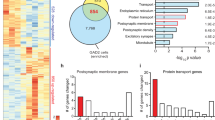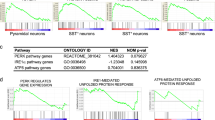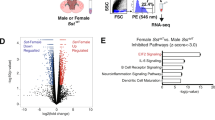Abstract
Somatostatin (SST) deficits are common pathological features in depression and other neurological disorders with mood disturbances, but little is known about the contribution of SST deficits to mood symptoms or causes of these deficits. Here we show that mice lacking SST (SstKO) exhibit elevated behavioral emotionality, high basal plasma corticosterone and reduced gene expression of Bdnf, Cortistatin and Gad67, together recapitulating behavioral, neuroendocrine and molecular features of human depression. Studies in SstKO and heterozygous (SstHZ) mice show that elevated corticosterone is not sufficient to reproduce the behavioral phenotype, suggesting a putative role for Sst cell-specific molecular changes. Using laser capture microdissection, we show that cortical SST-positive interneurons display significantly greater transcriptome deregulations after chronic stress compared with pyramidal neurons. Protein translation through eukaryotic initiation factor 2 (EIF2) signaling, a pathway previously implicated in neurodegenerative diseases, was most affected and suppressed in stress-exposed SST neurons. We then show that activating EIF2 signaling through EIF2 kinase inhibition mitigated stress-induced behavioral emotionality in mice. Taken together, our data suggest that (1) low SST has a causal role in mood-related phenotypes, (2) deregulated EIF2-mediated protein translation may represent a mechanism for vulnerability of SST neurons and (3) that global EIF2 signaling has antidepressant/anxiolytic potential.
This is a preview of subscription content, access via your institution
Access options
Subscribe to this journal
Receive 12 print issues and online access
$259.00 per year
only $21.58 per issue
Buy this article
- Purchase on Springer Link
- Instant access to full article PDF
Prices may be subject to local taxes which are calculated during checkout



Similar content being viewed by others
References
Kendler KS, Prescott CA, Myers J, Neale MC . The structure of genetic and environmental risk factors for common psychiatric and substance use disorders in men and women. Arch Gen Psychiatry 2003; 60: 929–937.
WHO World Health Organization—The Global Burden of Disease—2004 Update. Geneva, Switzerland WHO Library, 2008.
Moylan S, Maes M, Wray NR, Berk M . The neuroprogressive nature of major depressive disorder: pathways to disease evolution and resistance, and therapeutic implications. Mol Psychiatry 2012; 18: 595–606.
Rush AJ, Trivedi MH, Wisniewski SR, Nierenberg AA, Stewart JW, Warden D et al. Acute and longer-term outcomes in depressed outpatients requiring one or several treatment steps: a STAR*D report. Am J Psychiatry 2006; 163: 1905–1917.
Lin LC, Sibille E . Reduced brain somatostatin in mood disorders: a common pathophysiological substrate and drug target? Front Pharmacol 2013; 4: 110.
Martel G, Dutar P, Epelbaum J, Viollet C . Somatostatinergic systems: an update on brain functions in normal and pathological aging. Front Endocrinol (Lausanne) 2012; 3: 154.
Tripp A, Oh H, Guilloux JP, Martinowich K, Lewis DA, Sibille E . Brain-derived neurotrophic factor signaling and subgenual anterior cingulate cortex dysfunction in major depressive disorder. Am J Psychiatry 2012; 169: 1194–1202.
Sibille E, Morris HM, Kota RS, Lewis DA . GABA-related transcripts in the dorsolateral prefrontal cortex in mood disorders. Int J Neuropsychopharmacol 2011; 14: 721–734.
Guilloux JP, Douillard-Guilloux G, Kota R, Wang X, Gardier AM, Martinowich K et al. Molecular evidence for BDNF- and GABA-related dysfunctions in the amygdala of female subjects with major depression. Mol Psychiatry 2012; 17: 1130–1142.
Tripp A, Kota RS, Lewis DA, Sibille E . Reduced somatostatin in subgenual anterior cingulate cortex in major depression. Neurobiol Dis 2011; 42: 116–124.
Hendry SH, Jones EG, Emson PC . Morphology, distribution, and synaptic relations of somatostatin- and neuropeptide Y-immunoreactive neurons in rat and monkey neocortex. J Neurosci 1984; 4: 2497–2517.
Melchitzky DS, Lewis DA . Dendritic-targeting GABA neurons in monkey prefrontal cortex: comparison of somatostatin- and calretinin-immunoreactive axon terminals. Synapse 2008; 62: 456–465.
Xu X, Roby KD, Callaway EM . Immunochemical characterization of inhibitory mouse cortical neurons: three chemically distinct classes of inhibitory cells. J Comp Neurol 2010; 518: 389–404.
Gentet LJ, Kremer Y, Taniguchi H, Huang ZJ, Staiger JF, Petersen CC . Unique functional properties of somatostatin-expressing GABAergic neurons in mouse barrel cortex. Nat Neurosci 2012; 15: 607–612.
Le Magueresse C, Monyer H . GABAergic interneurons shape the functional maturation of the cortex. Neuron 2013; 77: 388–405.
DeFelipe J, Lopez-Cruz PL, Benavides-Piccione R, Bielza C, Larranaga P, Anderson S et al. New insights into the classification and nomenclature of cortical GABAergic interneurons. Nat Rev Neurosci 2013; 14: 202–216.
Zeyda T, Diehl N, Paylor R, Brennan MB, Hochgeschwender U . Impairment in motor learning of somatostatin null mutant mice. Brain Res 2001; 906: 107–114.
Agren H, Lundqvist G . Low levels of somatostatin in human CSF mark depressive episodes. Psychoneuroendocrinology 1984; 9: 233–248.
Molchan SE, Lawlor BA, Hill JL, Martinez RA, Davis CL, Mellow AM et al. CSF monoamine metabolites and somatostatin in Alzheimer's disease and major depression. Biol Psychiatry 1991; 29: 1110–1118.
Kling MA, Rubinow DR, Doran AR, Roy A, Davis CL, Calabrese JR et al. Cerebrospinal fluid immunoreactive somatostatin concentrations in patients with Cushing’s disease and major depression: relationship to indices of corticotropin-releasing hormone and cortisol secretion. Neuroendocrinology 1993; 57: 79–88.
Molchan SE, Hill JL, Martinez RA, Lawlor BA, Mellow AM, Rubinow DR et al. CSF somatostatin in Alzheimer’s disease and major depression: relationship to hypothalamic-pituitary-adrenal axis and clinical measures. Psychoneuroendocrinology 1993; 18: 509–519.
Swaab DF, Bao AM, Lucassen PJ . The stress system in the human brain in depression and neurodegeneration. Ageing Res Rev 2005; 4: 141–194.
Holsboer F . The corticosteroid receptor hypothesis of depression. Neuropsychopharmacology 2000; 23: 477–501.
Belmaker RH, Agam G . Major depressive disorder. N Engl J Med 2008; 358: 55–68.
Stengel A, Rivier J, Tache Y . Central actions of somatostatin-28 and oligosomatostatin agonists to prevent components of the endocrine, autonomic and visceral responses to stress through interaction with different somatostatin receptor subtypes. Curr Pharm Des 2013; 19: 98–105.
Fisher DA, Brown MR . Somatostatin analog: plasma catecholamine suppression mediated by the central nervous system. Endocrinology 1980; 107: 714–718.
Brown MR, Rivier C, Vale W . Central nervous system regulation of adrenocorticotropin secretion: role of somatostatins. Endocrinology 1984; 114: 1546–1549.
Stengel A, Goebel-Stengel M, Wang L, Luckey A, Hu E, Rivier J et al. Central administration of pan-somatostatin agonist ODT8-SST prevents abdominal surgery-induced inhibition of circulating ghrelin, food intake and gastric emptying in rats. Neurogastroenterol Motil 2011; 23: e294–e308.
Keller MC, Neale MC, Kendler KS . Association of different adverse life events with distinct patterns of depressive symptoms. Am J Psychiatry 2007; 164: 1521–1529, quiz 1622.
Vezzani A, Hoyer D . Brain somatostatin: a candidate inhibitory role in seizures and epileptogenesis. Eur J Neurosci 1999; 11: 3767–3776.
Ponomarev I, Rau V, Eger EI, Harris RA, Fanselow MS . Amygdala transcriptome and cellular mechanisms underlying stress-enhanced fear learning in a rat model of posttraumatic stress disorder. Neuropsychopharmacology 2010; 35: 1402–1411.
Martinowich K, Schloesser RJ, Jimenez DV, Weinberger DR, Lu B . Activity-dependent brain-derived neurotrophic factor expression regulates cortistatin-interneurons and sleep behavior. Mol Brain 2011; 4: 11.
Glorioso C, Sabatini M, Unger T, Hashimoto T, Monteggia LM, Lewis DA et al. Specificity and timing of neocortical transcriptome changes in response to BDNF gene ablation during embryogenesis or adulthood. Mol Psychiatry 2006; 11: 633–648.
Grosse G, Djalali S, Deng DR, Holtje M, Hinz B, Schwartzkopff K et al. Area-specific effects of brain-derived neurotrophic factor (BDNF) genetic ablation on various neuronal subtypes of the mouse brain. Brain Res Dev Brain Res 2005; 156: 111–126.
Duman RS, Heninger GR, Nestler EJ . A molecular and cellular theory of depression. Arch Gen Psychiatry 1997; 54: 597–606.
Albrecht A, Thiere M, Bergado-Acosta JR, Poranzke J, Muller B, Stork O . Circadian modulation of anxiety: a role for somatostatin in the amygdala. PLoS One 2013; 8: e84668.
Yeung M, Engin E, Treit D . Anxiolytic-like effects of somatostatin isoforms SST 14 and SST 28 in two animal models (Rattus norvegicus) after intra-amygdalar and intra-septal microinfusions. Psychopharmacology (Berl) 2011; 216: 557–567.
Yeung M, Treit D . The anxiolytic effects of somatostatin following intra-septal and intra-amygdalar microinfusions are reversed by the selective sst2 antagonist PRL2903. Pharmacol Biochem Behav 2012; 101: 88–92.
Soumier A, Sibille E . Opposing effects of acute versus chronic blockade of frontal cortex somatostatin-positive inhibitory neurons on behavioral emotionality in mice. Neuropsychopharmacology 2014; 39: 2252–2262.
Taniguchi H, He M, Wu P, Kim S, Paik R, Sugino K et al. A resource of Cre driver lines for genetic targeting of GABAergic neurons in cerebral cortex. Neuron 2011; 71: 995–1013.
Surget A, Wang Y, Leman S, Ibarguen-Vargas Y, Edgar N, Griebel G et al. Corticolimbic transcriptome changes are state-dependent and region-specific in a rodent model of depression and of antidepressant reversal. Neuropsychopharmacology 2009; 34: 1363–1380.
Sibille E, Pavlides C, Benke D, Toth M . Genetic inactivation of the serotonin(1A) receptor in mice results in downregulation of major GABA(A) receptor alpha subunits, reduction of GABA(A) receptor binding, and benzodiazepine-resistant anxiety. J Neurosci 2000; 20: 2758–2765.
Guilloux JP, Seney M, Edgar N, Sibille E . Integrated behavioral z-scoring increases the sensitivity and reliability of behavioral phenotyping in mice: relevance to emotionality and sex. J Neurosci Methods 2011; 197: 21–31.
David DJ, Samuels BA, Rainer Q, Wang JW, Marsteller D, Mendez I et al. Neurogenesis-dependent and -independent effects of fluoxetine in an animal model of anxiety/depression. Neuron 2009; 62: 479–493.
Lin LC, Lewis DA, Sibille E . A human–mouse conserved sex bias in amygdala gene expression related to circadian clock and energy metabolism. Mol Brain 2011; 4: 18.
Ma T, Trinh MA, Wexler AJ, Bourbon C, Gatti E, Pierre P et al. Suppression of eIF2alpha kinases alleviates Alzheimer's disease-related plasticity and memory deficits. Nat Neurosci 2013; 16: 1299–1305.
Moreno JA, Halliday M, Molloy C, Radford H, Verity N, Axten JM et al. Oral treatment targeting the unfolded protein response prevents neurodegeneration and clinical disease in prion-infected mice. Sci Transl Med 2013; 5: 206ra138.
Kim HJ, Raphael AR, Ladow ES, McGurk L, Weber RA, Trojanowski JQ et al. Therapeutic modulation of eIF2alpha phosphorylation rescues TDP-43 toxicity in amyotrophic lateral sclerosis disease models. Nat Genet 2014; 46: 152–160.
Caspi A, Sugden K, Moffitt TE, Taylor A, Craig IW, Harrington H et al. Influence of life stress on depression: moderation by a polymorphism in the 5-HTT gene. Science 2003; 301: 386–389.
Sibille E, Wang Y, Joeyen-Waldorf J, Gaiteri C, Surget A, Oh S et al. A molecular signature of depression in the amygdala. Am J Psychiatry 2009; 166: 1011–1024.
Nollet M, Le Guisquet AM, Belzung C . Models of depression: unpredictable chronic mild stress in mice. Curr Protoc Pharmacol 2013; Chapter 5, Unit 5: 65.
Scalera G, Tarozzi G . Somatostatin administration modifies food intake, body weight, and gut motility in rat. Peptides 1998; 19: 991–997.
Ricci GL, Fevery J . Somatostatin inhibits the effect of secretin on bile flow and on hepatic bilirubin transport in the rat. Gut 1989; 30: 1266–1269.
de Lecea L, del Rio JA, Criado JR, Alcantara S, Morales M, Danielson PE et al. Cortistatin is expressed in a distinct subset of cortical interneurons. J Neurosci 1997; 17: 5868–5880.
Viollet C, Lepousez G, Loudes C, Videau C, Simon A, Epelbaum J . Somatostatinergic systems in brain: networks and functions. Mol Cell Endocrinol 2008; 286: 75–87.
de Lecea L . Cortistatin—functions in the central nervous system. Mol Cell Endocrinol 2008; 286: 88–95.
Nagata T, Ilieva H, Murakami T, Shiote M, Narai H, Ohta Y et al. Increased ER stress during motor neuron degeneration in a transgenic mouse model of amyotrophic lateral sclerosis. Neurol Res 2007; 29: 767–771.
Kramer A, Green J, Pollard J Jr, Tugendreich S . Causal analysis approaches in Ingenuity Pathway Analysis. Bioinformatics 2014; 30: 523–530.
Ardayfio P, Kim KS . Anxiogenic-like effect of chronic corticosterone in the light-dark emergence task in mice. Behav Neurosci 2006; 120: 249–256.
Harding HP, Novoa I, Zhang Y, Zeng H, Wek R, Schapira M et al. Regulated translation initiation controls stress-induced gene expression in mammalian cells. Mol Cell 2000; 6: 1099–1108.
Moreno JA, Radford H, Peretti D, Steinert JR, Verity N, Martin MG et al. Sustained translational repression by eIF2alpha-P mediates prion neurodegeneration. Nature 2012; 485: 507–511.
Boyce M, Bryant KF, Jousse C, Long K, Harding HP, Scheuner D et al. A selective inhibitor of eIF2alpha dephosphorylation protects cells from ER stress. Science 2005; 307: 935–939.
Axten JM, Medina JR, Feng Y, Shu A, Romeril SP, Grant SW et al. Discovery of 7-methyl-5-(1-{[3-(trifluoromethyl)phenyl]acetyl}-2,3-dihydro-1H-indol-5-yl)-7H-pyrrolo[2,3-d]pyrimidin-4-amine (GSK2606414), a potent and selective first-in-class inhibitor of protein kinase R (PKR)-like endoplasmic reticulum kinase (PERK). J Med Chem 2012; 55: 7193–7207.
Santarelli L, Saxe M, Gross C, Surget A, Battaglia F, Dulawa S et al. Requirement of hippocampal neurogenesis for the behavioral effects of antidepressants. Science 2003; 301: 805–809.
Carroll BJ, Schroeder K, Mukhopadhyay S, Greden JF, Feinberg M, Ritchie J et al. Plasma dexamethasone concentrations and cortisol suppression response in patients with endogenous depression. J Clin Endocrinol Metab 1980; 51: 433–437.
Burgus R, Ling N, Butcher M, Guillemin R . Primary structure of somatostatin, a hypothalamic peptide that inhibits the secretion of pituitary growth hormone. Proc Natl Acad Sci USA 1973; 70: 684–688.
de Kloet ER, Sarabdjitsingh RA . Everything has rhythm: focus on glucocorticoid pulsatility. Endocrinology 2008; 149: 3241–3243.
Phillips ML, Drevets WC, Rauch SL, Lane R . Neurobiology of emotion perception II: implications for major psychiatric disorders. Biol Psychiatry 2003; 54: 515–528.
Mayberg HS, Liotti M, Brannan SK, McGinnis S, Mahurin RK, Jerabek PA et al. Reciprocal limbic–cortical function and negative mood: converging PET findings in depression and normal sadness. Am J Psychiatry 1999; 156: 675–682.
Brody AL, Saxena S, Mandelkern MA, Fairbanks LA, Ho ML, Baxter LR . Brain metabolic changes associated with symptom factor improvement in major depressive disorder. Biol Psychiatry 2001; 50: 171–178.
Kim SS, Wang H, Li XY, Chen T, Mercaldo V, Descalzi G et al. Neurabin in the anterior cingulate cortex regulates anxiety-like behavior in adult mice. Mol Brain 2011; 4: 6.
Ramirez JL, Mouchantaf R, Kumar U, Otero Corchon V, Rubinstein M, Low MJ et al. Brain somatostatin receptors are up-regulated in somatostatin-deficient mice. Mol Endocrinol 2002; 16: 1951–1963.
Cammalleri M, Cervia D, Dal Monte M, Martini D, Langenegger D, Fehlmann D et al. Compensatory changes in the hippocampus of somatostatin knockout mice: upregulation of somatostatin receptor 2 and its function in the control of bursting activity and synaptic transmission. Eur J Neurosci 2006; 23: 2404–2422.
Pothion S, Bizot JC, Trovero F, Belzung C . Strain differences in sucrose preference and in the consequences of unpredictable chronic mild stress. Behav Brain Res 2004; 155: 135–146.
Willner P, Towell A, Sampson D, Sophokleous S, Muscat R . Reduction of sucrose preference by chronic unpredictable mild stress, and its restoration by a tricyclic antidepressant. Psychopharmacology (Berl) 1987; 93: 358–364.
Ron D, Walter P . Signal integration in the endoplasmic reticulum unfolded protein response. Nat Rev Mol Cell Biol 2007; 8: 519–529.
Valdes P, Mercado G, Vidal RL, Molina C, Parsons G, Court FA et al. Control of dopaminergic neuron survival by the unfolded protein response transcription factor XBP1. Proc Natl Acad Sci USA 2014; 111: 6804–6809.
Leitman J, Barak B, Benyair R, Shenkman M, Ashery U, Hartl FU et al. ER stress-induced eIF2-alpha phosphorylation underlies sensitivity of striatal neurons to pathogenic huntingtin. PLoS One 2014; 9: e90803.
Saxena S, Cabuy E, Caroni P . A role for motoneuron subtype-selective ER stress in disease manifestations of FALS mice. Nat Neurosci 2009; 12: 627–636.
Hetz C, Mollereau B . Disturbance of endoplasmic reticulum proteostasis in neurodegenerative diseases. Nat Rev Neurosci 2014; 15: 233–249.
Calfon M, Zeng H, Urano F, Till JH, Hubbard SR, Harding HP et al. IRE1 couples endoplasmic reticulum load to secretory capacity by processing the XBP-1 mRNA. Nature 2002; 415: 92–96.
Kakiuchi C, Iwamoto K, Ishiwata M, Bundo M, Kasahara T, Kusumi I et al. Impaired feedback regulation of XBP1 as a genetic risk factor for bipolar disorder. Nat Genet 2003; 35: 171–175.
Hayashi A, Kasahara T, Kametani M, Kato T . Attenuated BDNF-induced upregulation of GABAergic markers in neurons lacking Xbp1. Biochem Biophys Res Commun 2008; 376: 758–763.
Zhu PJ, Huang W, Kalikulov D, Yoo JW, Placzek AN, Stoica L et al. Suppression of PKR promotes network excitability and enhanced cognition by interferon-gamma-mediated disinhibition. Cell 2011; 147: 1384–1396.
Trinh MA, Kaphzan H, Wek RC, Pierre P, Cavener DR, Klann E . Brain-specific disruption of the eIF2alpha kinase PERK decreases ATF4 expression and impairs behavioral flexibility. Cell Rep 2012; 1: 676–688.
Acknowledgements
We thank Chien-Wei Lin and Ying Ding for assistance with the microarray data preprocessing, Ye Chen for assistance with behavioral testing and Beverly French for comments on the manuscript. This work was supported by grants from National Institute of Mental Health (NIMH-MH093723, MH084060 and MH077159).
Author information
Authors and Affiliations
Corresponding author
Ethics declarations
Competing interests
The authors declare no conflict of interest.
Additional information
Supplementary Information accompanies the paper on the Molecular Psychiatry website
Supplementary information
Rights and permissions
About this article
Cite this article
Lin, L., Sibille, E. Somatostatin, neuronal vulnerability and behavioral emotionality. Mol Psychiatry 20, 377–387 (2015). https://doi.org/10.1038/mp.2014.184
Received:
Revised:
Accepted:
Published:
Issue Date:
DOI: https://doi.org/10.1038/mp.2014.184
This article is cited by
-
Circuit- and laminar-specific regulation of medial prefrontal neurons by chronic stress
Cell & Bioscience (2023)
-
Perceptual learning deficits mediated by somatostatin releasing inhibitory interneurons of olfactory bulb in an early life stress mouse model
Molecular Psychiatry (2023)
-
Tianeptine promotes lasting antiallodynic effects in a mouse model of neuropathic pain
Neuropsychopharmacology (2023)
-
M1 acetylcholine receptors in somatostatin interneurons contribute to GABAergic and glutamatergic plasticity in the mPFC and antidepressant-like responses
Neuropsychopharmacology (2023)
-
Molecular origin of somatostatin-positive neuron vulnerability
Molecular Psychiatry (2022)



